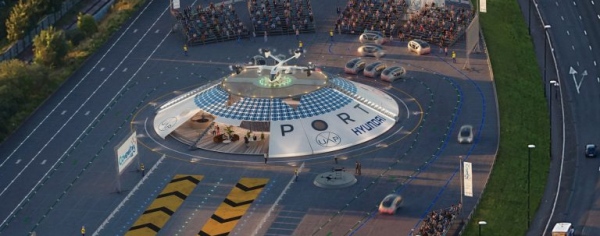Urban air travel, this is not
Even if there were enough air to do it.

The problem: While consumers and businesses are increasingly converting to electric ground vehicles, air travel remains a carbon-intensive industry.
The solution, according to a UK-based startup Urban-Air Port and Hyundai: build 65 airports for electric aircrafts, including VTOL ones (VTOL = Vertical Take-Off and Landing), in “key locations” across the US, UK, EU, and Asia Pacific.
A Hyundai manager declared that urban Air Mobility:
“will be integral to how we get from A to B this century”, and that this plan will _“take urban air mobility from science fiction to tangible reality”, by “unlocking clean urban air transport for everyone, improving connectivity in congested cities”.
What is missing in this picture?
If that article is a complete description of the plan and its objectives, nothing. Except space, and another important detail.
To begin with, let’s learn from Star Wars:

Urban air mobility will not improve connectivity. It will just move it up. Unless it’s not for “consumers”, but only for the elites, of course. See here and here my skepticism about this whole discourse, that remains unaltered by this plan.
Second, those statements about fixing “air travel, the carbon-intensive industry” sound to me like some three card monte, straight out of the “Now You See me” movies:

Read again all those statements. They are explicitly about urban air travel, that is something inside or among relatively close cities, which basically does not exist today. Building 65 electric urban airports would only compete with high speed trains. NOT with the actual “carbon-intensive air travel industry”.
- sneaky. Talks of air travel, but then promotes something that, if it worked, would add to the existing air travel, not replace it
Who writes this, why, and how to help
I am Marco Fioretti, tech writer and aspiring polymath doing human-digital research and popularization.
I do it because YOUR civil rights and the quality of YOUR life depend every year more on how software is used AROUND you.
To this end, I have already shared more than a million words on this blog, without any paywall or user tracking, and am sharing the next million through a newsletter, also without any paywall.
The more direct support I get, the more I can continue to inform for free parents, teachers, decision makers, and everybody else who should know more stuff like this. You can support me with paid subscriptions to my newsletter, donations via PayPal (mfioretti@nexaima.net) or LiberaPay, or in any of the other ways listed here.THANKS for your support!